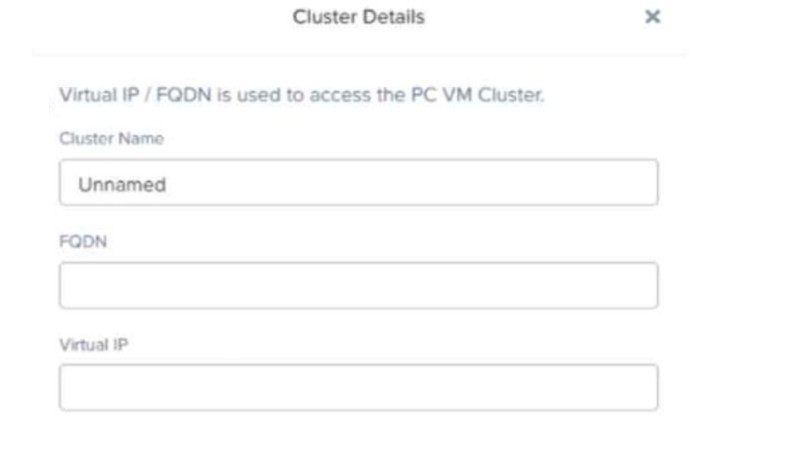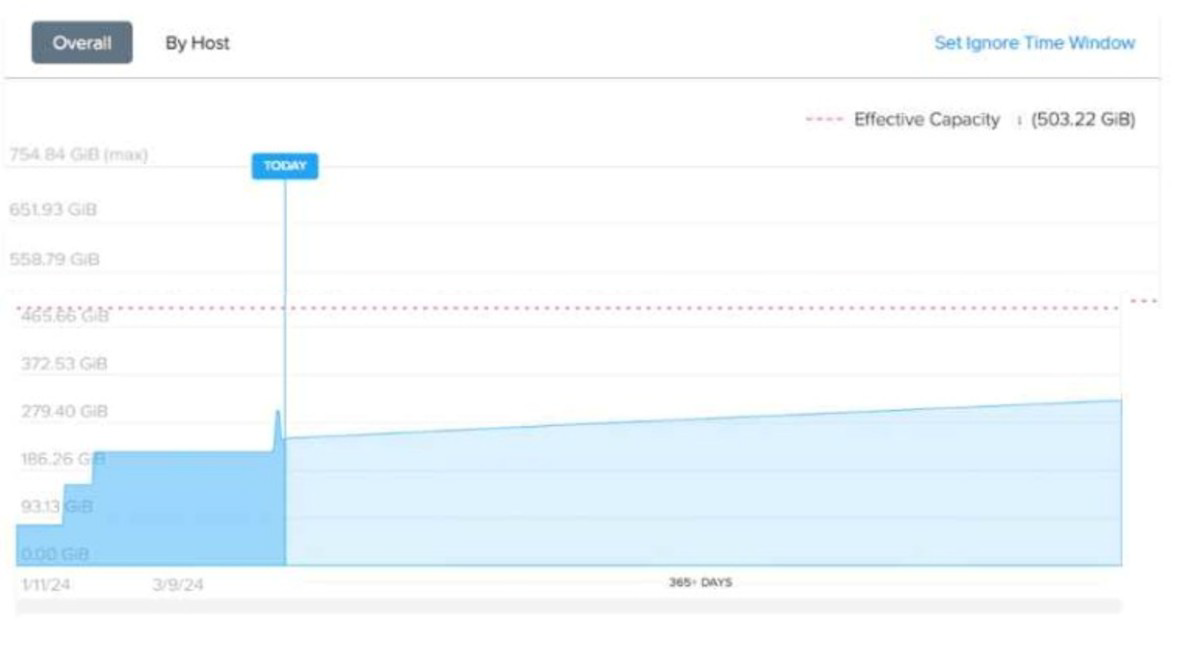| Page 1 out of 13 Pages |
An administrator is trying to configure Metro Availability between Nutanix ESXi-based
clusters. However, the Compatible Remote Sites screen does not list all required storage
containers.
Which two reasons could be a cause for this issue? (Choose two.)
A. Source and destination hardware are from different vendors.
B. The remote site storage container has compression enabled.
C. The destination storage container is not empty.
D. Both storage containers must have the same name.
Explanation:
Metro Availability in Nutanix requires that the primary and secondary storage
containers be configured identicallyto ensuredata replication consistency.
Option C (The destination storage container is not empty) is correct:
Option D (Both storage containers must have the same name) is correct:
Option A is incorrect: Metro Availability works regardless of hardware vendor
differences.
Option B is incorrect:Compression does not affect compatibilitybut may impact
performance.
Refer to Exhibit:
In a scale-out Prism Central deployment, what additional functionality does configuring
an FQDN instead of a Virtual IP provide?
A. Load balancing
B. Resiliency
C. Segmentation
D. SSL Certificate
Explanation:
When using FQDN instead of a Virtual IP in a scale-out Prism Central deployment, Nutanix enables load balancing across multiple Prism Central instances.
Option A (Load balancing) is correct because it ensures that requests are distributed among multiple Prism Central nodes, improving performance and
redundancy.
Option B (Resiliency) is incorrect because resiliency is achieved through HA and
replication, not through FQDN configuration.
Option C (Segmentation) is incorrect because network segmentation is handled at
the VLAN or security policy level.
Option D (SSL Certificate) is incorrect because SSL certificates can be applied
regardless of whether FQDN or Virtual IP is used.
Refer to the Exhibit:
An administrator needs to create two virtual machines: VM4 and VM5 that leverage the
memory over-commit feature.
Once VM4 is created and running, the administrator notices that it uses only 28GB of RAM.
What will be the maximum RAM that can be allocated to VM5 so that it can be powered
on?
A. 4GB
B. 8GB
C. 16GB
D. 32GB
Explanation:
Understanding the Exhibit & Memory Allocation
The host has 128GB of physical RAM.
The current memory allocation a cross three VMs (VM1, VM2, VM3) is 128GB, but
only92GB is actually utilized.
This means there is36GB of unutilized memory available for allocation.
Step-by-Step Breakdown
Existing Memory Usage Before Adding VM4
After Creating and Running VM4
Maximum Memory Allocation for VM5
Evaluating the Answer Choices
(A) 4GB(Incorrect)
(B) 8GB(Correct)
(C) 16GB(Incorrect)
(D) 32GB(Incorrect)
Key Concept: Nutanix Memory Overcommit
Nutanix AHV supports memory overcommit, meaning VMs can be allocated more
memory than physically available using memory ballooning and swapping.
However, to power on VM5 without impacting performance, it must fit within the
available unutilized memory, which is 8GB.
Refer to Exhibit:
An administrator sees the alert shown in the exhibit.
What should the administrator do to ensure the nutanix user can no longer SSH to a CVM
using a password?
A. Rename the nutanix user.
B. Block port 22 on the CVM firewall.
C. Enable Cluster Lockdown.
D. Delete the nutanix user.
Explanation:
Understanding the Exhibit & the Alert
The alert states:
"The cluster is using password-based SSH access for the CVM."
"Password-based remote login is enabled on the cluster."
"It is recommended to use key-based SSH access instead of password-based
SSH access for better security."
This means that the nutanix user can log in to Controller VMs (CVMs) using a
password, which is a security risk.
Corrective Action: Enabling Cluster Lockdown
(C) Enable Cluster Lockdown. (Correct Answer)
Cluster Lockdown Mode restricts password-based SSH access and forces keybased
authentication.
This prevents users from logging into CVMs using passwords, enhancing cluster
security.
To enable Cluster Lockdown:
Evaluating the Other Answer Choices
(A) Rename the nutanix user. (Incorrect)
The nutanix user is a built-in system account required for cluster operations.
Renaming the user will not prevent SSH access via password.
(B) Block port 22 on the CVM firewall. (Incorrect)
Blocking port 22 (SSH) will completely disable SSH access, including key-based
authentication.
This may break cluster management and troubleshooting operations.
(D) Delete the nutanix user. (Incorrect)
The nutanix user is a critical system account required for cluster functionality.
Deleting the account will cause serious issues with cluster management.
Refer to Exhibit:
An administrator is looking at thememory cluster runway diagramas shown in exhibit,in
Prism Central. The environment has three hosts with the following configuration:
CPU: 2x Intel Xeon Gold (8 cores, 2.6 GHz)
RAM: 256 GB per host
Storage: SSDs and HDDs
The Intelligent Operations feature has been active for one month, but no further
configurations were applied.
What does the dotted red line mean?
A. It is the default trend analysis static threshold that can be manually set.
B. It is the maximum memory the administrator can assign to VMs.
C. It is the calculated memory oversubscription limit for currently running VMs.
D. It is the usable capacity based on cluster configuration options.
Explanation:
The Prism Central Memory Cluster Runway Diagram provides insights into memory usage
trends, predicting how long the cluster can sustain workloads before exhausting resources.
The solid blue area represents the actual memory consumption over time.
The dotted red liner presents the effective memory capacity limit based on the
cluster's current configuration.
Analyzing the Dotted Red Line
The dotted red line is labeled "Effective Capacity: 503.22 GiB", which means:
It is the total usable memory capacity IN the cluster after considering hypervisor overhead, redundancy settings, and failover capacity.
This value is not a hard limit but an indication of the available memory before
potential performance issues occur.
Evaluating the Answer Choices
(A) It is the default trend analysis static threshold that can be manually set.(Incorrect
)
The dotted red line is not a static threshold that an administrator can manually
configure.
Trend analysis in Prism is dynamic and based on workload history and projections.
(B) It is the maximum memory the administrator can assign to VMs.(Incorrect)
Administrators can over subscribe memory beyond the dotted red line if memory
over commitment is enabled.
However, oversubscribing memory beyond effective capacity may impact
performance.
(C) It is the calculated memory oversubscription limit for currently running VMs.(
Incorrect)
The dotted red line does not represent oversubscription limits.
Memory oversubscription depends on hypervisor memory ballooning, compression,
and swapping mechanisms, which are not directly shown here.
(D) It is the usable capacity based on cluster configuration options.(Correct Answer)
The dotted red line (503.22 GiB)represents the actual usable memory available in
the cluster after factoring in system overhead.
Refer to Exhibit:
An administrator notices the message shown in the exhibit when navigating to LCM from
Prism Central.
Which action should the administrator take to update LCM to the latest version?
A. Run anAOS upgrade.
B. Run anAHV upgrade.
C. Perform an Inventory Scan.
D. Download and install the latest LCM version from a CVM.
Explanation:
When Life Cycle Manager (LCM) reports that a newer framework version is available, the
correct action is to perform an inventory scan (Option C).
Performing an inventory scan updates the available firmware/software versions and
allows LCM to download required updates.
Option A (Run an AOS upgrade)is unrelated to the LCM framework update
process.
Option B (Run an AHV upgrade)is a separate component update and does not
affect the LCM framework.
Option D (Download manually from a CVM)is not necessary because LCM
updates are automatically pulled after an inventory scan.
| Page 1 out of 13 Pages |